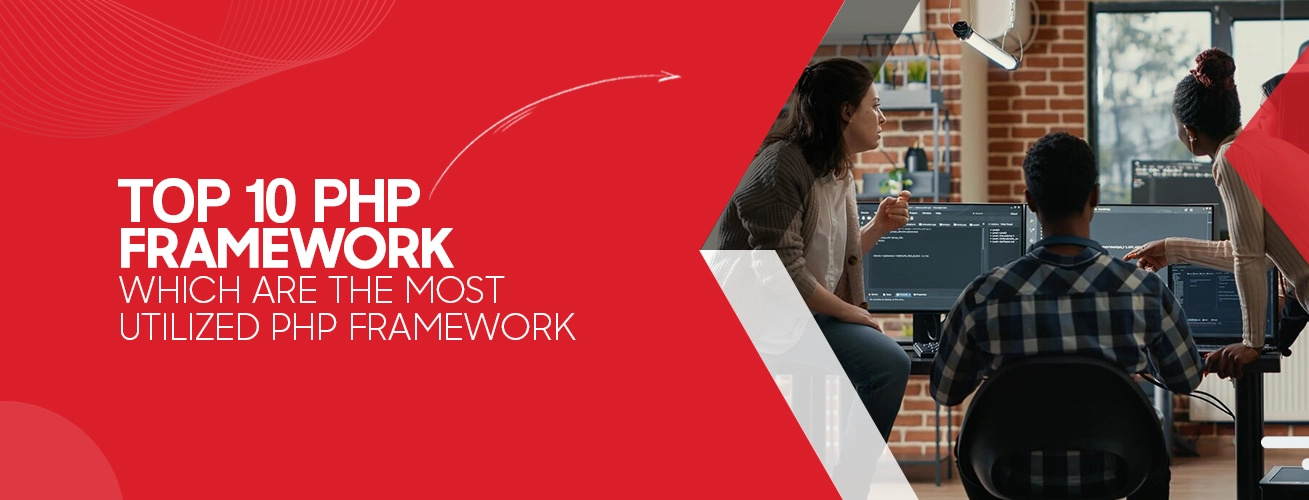Top 10 PHP Frameworks Which are the Most Utilized in 2024
Do you know what Facebook uses for its end-to-end computing infrastructure? What programming languages are Wikipedia, MailChimp, Slack, Tumblr, and WordPress deploying for small-large mobile apps and website products?
You may find it surprising. It is a PHP framework. In this age of large-scale tech stacks for back-end development, multiple Fortune 500 startups have decided to choose the PHP framework for web development. It could be intriguing, but when you look at the simplicity, security, code maintainability, and ease of development offered by PHP frameworks, you will know that these server-side programming languages deserve this selection.
Hypertext preprocessors, or simply PHP frameworks, are now the most preferred choice when it comes to programming languages. They empower more than 75% of all websites worldwide. Other programming languages such as Python, Ruby, Java, and Elixir, though they have their advantages, are no match for this fast-growing web and mobile app development tool.
In this blog, we will help you know why you should choose these frameworks, What’s more, we will also let you know which framework best suits your requirements.
Are you ready for this exciting journey? Let’s get the ball rolling!
Why Should You Select a PHP Frameworks?
Selecting a programming language can be quite a consequential decision. It would determine the web performance, and by extension, the overall revenue-earning and profit-making abilities of your website.
Here are some good reasons to choose PHP frameworks as opposed to other programming languages.
-
Dynamic Community and Ecosystems:
PHP frameworks have a large, growing, and dynamic community. This forthcoming community can help you tap into vast and readily available resources such as tutorials, documentation, and code examples. You can thus execute web and mobile app development projects without any hiccups.
Secondly, PHP offers a rich and extensive ecosystem of extensions and plugins. You can deploy them to add new functionalities and features without worrying about writing new codes. That is certainly a great help.
-
Quick Development:
These frameworks come with built-in libraries and tools, helping you to accelerate the development cycle. You don’t need to reinvent the wheel every time you sit for development because they come with built-in build blocks. For instance, you will have security measures, database interactions, and routing. Therefore, you can focus on writing code to incorporate specific functionalities to meet special needs.
For instance, the Cake PHP framework comes with the Bake Command Line Tool, allowing developers to have a readily available skeleton code, saving them precious time and effort. The same is the case with other PHP frameworks that offer well-integrated PHP Unit libraries for accelerated execution of projects.
-
Clean and organized codes:
They have support for writing codes that are cleaner and more organized, improving readability and maintainability. Furthermore, PHP frameworks adhere to the best coding practices.
For instance, they are capable of organizing codes efficiently into several directories as per their functions. Second, they support the enforcement of naming conventions for entities, helping web and mobile app developers come up with cleaner and more organized code. This helps other developers comprehend code and make changes as needed in the future.
What’s more, PHP frameworks are pre-equipped with input validation and session management security features, allowing you to reduce vulnerabilities and offer better security against various forms of cyber-attacks.
-
Better Teamwork:
The ability of PHP frameworks to provide a consistent structure, enabling developers to collaborate and work under perfect teamwork conditions. The collaboration allows developers to work seamlessly on different parts of projects and ensure project completion within the set timeline.
These frameworks offer clarity on documentation, design decisions, and code standards. This clarity allows all team members to work collaboratively for improved efficiency and productivity.
-
Easy Maintainability:
Support for DRY (Don’t Repeat Yourself) development and enabling support for refactoring of code ensures leaner database needs. This, in return, demands less maintenance.
Furthermore, the ability to produce well-organized codes and best coding practices leads to simplified maintenance.
These are some of the many reasons that show why PHP frameworks are now the talk of the town. But when there are many options available under this programming language, which framework best serves your interests?
Here is the answer to help you make a well-informed decision concerning selecting the most suitable PHP framework. But first, we look at which factors you must take into consideration before making an ultimate choice.
Factors to Look into A Suitable PHP Frameworks:
Here are key factors to ensure that the PHP framework you choose is perfectly aligned with your project requirements:
-
Learning Curve:
The familiarity of your development team with the framework is crucial because it would flatten the learning curve. If a team is unfamiliar, it can cost you a lot. There should be a balance between familiarity and benefits. Do keep this in mind.
A framework with advanced features can help you accelerate the development process, and allow you more customization, but if your team is not well-versed in it, you will not be able to effectively utilize the features.
Hence, do have a balance and give careful thought to possible trade-offs.
-
Cost & Licensing:
Quite understandably, cost and licensing terms should be the top determinants. You must look into what cost the framework is set to create and what licensing terms you will have to comply with.
-
Maintenance and Support:
Any good framework must offer dedicated support services, active maintenance, regular updates, and patch management. These are essential for security patches, fixing bugs, and keeping web and mobile app solutions secure and protected.
-
Community Support:
You should look for active and readily available community support. The PHP framework must offer a vast wealth of documentation, tutorials, and other resources to overcome challenges in the way of web app development.
-
Performance:
You must choose a PHP framework that features performance optimization through various means, such as efficient database query handling, efficient code writing, and caching mechanisms.
Now, we come to the point: finding the best-serving PHP framework for your business.
Top 10 Most Popular Frameworks in 2024:
Here is a list of the most utilized PHP frameworks in 2024.
- Laravel
- Symfony
- CodeIgniter
- CakePHP
- Yii 2
- Zend Framework
- Slim
- Phalcon
- Fat-Free Framework
- Fuel PHP
-
Laravel:
Launched in 2011, Laravel has become one of the most popular PHP web application frameworks. With over 650,000 active websites that are using this PHP web app framework, it has successfully allowed many businesses to remain profitable in the market.
Expertise in Laravel web application development allows software houses to exploit the potential of this open-source framework and deliver cutting-edge and reliable online applications. Web developers love this platform because it allows them to write clean and maintainable code and deliver performance-optimized websites.
Key Features of Laravel:
- It has built-in support for the Model-View-Controller (MVC) architecture. This enables web and mobile app developers to ensure code optimization and maintainability. Furthermore, the separation of concerns helps web developers build scalable and maintainable applications.
- Laravel provides a secure development environment because it has built-in and out-of-box configurations for authentication and authorization.
- It can simplify database interactions through eloquent Object-Relational-Mapper (ORM) support. ORM is a key to ensuring efficient database operations and expressive queries.
- This web app framework features an innovative Blade Template Engine. This feature allows web developers to access clean and intuitive syntax for producing HTML templates, thereby ensuring seamless integration of PHP codes with your views.
- Other important features are seamless data migration, low server overhead, and a vast Laravel community.
Drawbacks of Laravel PH Web App Framework:
There are some drawbacks as well. For instance:
- Reverse routing and caching are complex, demanding expertise and highly skilled IT professionals.
- Sometimes, upgrades prove problematic and can potentially cause some hiccups.
- More importantly, legacy systems are not transferred to Laravel, causing some issues.
When to deploy Laravel for Web App and API Development:
Laravel PHP web applications best serve when you are looking for scalable web applications, custom CMSs, and e-commerce platforms.
System Requirements for Smooth Operation:
There are a few system requirements for the smooth functioning of Laravel. You must make sure that your web server has a minimum PHP >= 8.1 PHP version.
Latest Version:
Version 10.0 is the latest version that has been available for the public since February 14, 2023.
-
CodeIgniter:
CodeIgniter is a PHP framework that is known for its small footprint. This lightweight PHP framework enables developers to build web and mobile app solutions quickly and with minimal code requirements for given tasks.
Though it is not based on MVC architecture, it allows quick and accelerated development by offering access to a large number of libraries, a logical architecture, and a simple interface.
Key Features of CodeIgniter:
- It is an open-sourced and lightweight PHP framework.
- It features flexible routing, helping web developers customize URLs to align perfectly with customers’ needs.
- The multiple caching helps developers accelerate the web and mobile app development processes.
- CodeIgniter also supports automated code generation and standardized structures that ensure consistency and efficient web development.
Limitations of CodeIgniter:
- This framework does have some drawbacks as well. For instance,
- It has a comparatively smaller number of libraries in comparison with other PHP frameworks.
- It does not have built-in support for ORM.
- More importantly, the lack of support for modular code separation is a headache for web developers, they would have to put extra effort to offset this.
CodeIgniter Deployment Scenarios:
You can use CodeIgniter Web App Development for smaller projects and when you develop web applications with minimal resources.
Minimum PHP Requirements:
You will need PHP version 7.4 or newer and some extensions such as intl, mastering, and JSON for the smooth functioning of CodeIgniter.
CodeIgniter’s Latest Version:
v4.4.5 is the latest version available for the public.
-
Symfony:
With a thriving community of over 300,000 developers, Symfony is also one of the most utilized PHP frameworks. The popularity of Symfony lies in its ability to help web developers adapt various applications as per customers’ needs.
Key Features of Symfony:
- Symfony features a component-based architecture for web development. The modular approach gives web developers the flexibility to ensure custom app development as per their needs.
- It is a model-view-controller-based PHP framework, allowing efficient development.
- The vast and thriving community is always there to help you sort things out.
- The ecosystem that Symfony supports is impressive. The 4,000 third-party bundles help you incorporate all functionalities, whether it is CMS, eCommerce, or integration with a payment gateway.
Shortcomings of Symfony Web App Framework:
- It has a steep learning curve, requiring more specialized skills and expertise than other PHP frameworks.
- Difficult file parsing is another major hurdle in the proper utilization of the Symfony PHP web app framework.
- It is only suitable for large projects; it is usually not deployed for small-scale web apps.
Deployment Scenarios:
It is suitable for projects requiring extensive customization, API, microservices, and large-scale web and mobile applications.
Minimum PHP requirements for Symfony Standard Edition:
It requires PHP 8.2.0 or higher for effective performance, along with some minor adjustments and requirements.
Latest Edition:
The latest patch version of Symfony is 7.0.5, which has been available for public use since November 2023.
-
CakePHP:
Based upon the convention-over-configuration principle, CakePHP provides a set of conventions that eliminates almost completely the need for writing code for repetitive tasks. This ensures Rapid Application Development (RAD).
Key features of CakePHP:
- Scaffolding and routine are some of the many built-in functionalities that can help developers get their ideas off the ground quickly.
- The coding conventions enable faster coding. Multiple pre-defined conventions, such as naming, code organization, and directory structures, speed up the development process.
- The security of CakePHP is also up to par.
-
Limitations of CakePHP:
- CakePHP is not suitable for large-scale applications.
- Requirements for updating default routes to create effective URLs warrant some effort and resources.
- Documentation also demands some improvement.
CakePHP is comparatively slower than other web application frameworks.
When to Deploy CakePHP:
If you want to develop applications quickly, go for it, strong conventions and default capabilities will help you ensure Rapid Application Development.
Installation and Running Requirements:
The minimum PHP version required for installation and running CakePHP is PHP 8.1 or higher. The web server’s PHP version should be the same as your CLI (Command Line Interface) uses.
Latest Version:
- 5.0.5 is the latest version of CakePHP.
-
Yii
Yii is one of the most trustworthy and widely used PHP web application frameworks. It is preferred for its simpler installation and extensions that ensure quicker and more efficient web development.
Yii web application development is thus a trustworthy way to build cutting-edge web and mobile applications.
Key Features:
- It is a back-end framework similar to Laravel.
- Yii offers robust and reliable security features.
- It has RESTful API development support that is key to efficient RESTful web services.
Drawbacks:
- Since it is a pure object-oriented programming language, developers need to learn OOP. It may end up on a steep learning curve.
- This framework does not support AR queries.
When to Choose Yii PHP Framework:
Yii is a framework of choice when developers need to build eCommerce solutions, CMS, portals, forums, and RESTful web services.
Minimum PHP Requirement:
8.0 or higher PHP version.
Latest Version:
3.2.24
Final Words:
There is no denying the fact that PHP frameworks are reigning supreme when it comes to web app and mobile app development. They are known for accelerating the development process, efficient resource utilization, better code maintainability, and simpler and expressive syntax.
There are multiple PHP framework options. Each has its unique capabilities and strengths. Knowing strengths and weaknesses is key to ensuring that you can choose a platform that best serves your interests. We have discussed the cons and pros of some of these PHP frameworks so that you can make an informed decision.
Big thanks for your reading. We are looking forward to receiving your feedback. Best wishes for your project.





